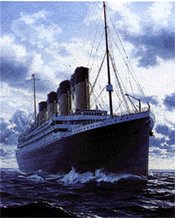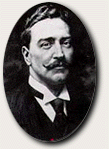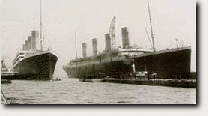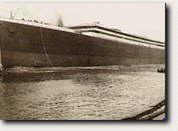
The Ship of Dreams - History - Construction

Bruce Ismay
O
n a summer night in 1907, Bruce Ismay, managing director of the White Star Line, and his wife Florence were having dinner at the Belgravia mansion, known as the Downshire House. This was the home of Lord James Pirrie, a partner in the firm of Harland and Wolff, the builder of all White Star vessels. Both Ismay and Pirrie were allied together in the fight for dominance over the Atlantic passenger trade, the chief rival being the Cunard Line.
Lord James Pirrie
T
he main topic of discussion that night concerned the new Cunard liner Lusitania. The huge passenger ship was expected to shatter the existing speed records on her maiden voyage. This would put Cunard ahead in the race for control of the Atlantic route. How wasWhite Star to answer this new threat?I
t is believed that during the dinner party that night Lord Pirrie and Ismay devised an ambitious plan. Using their combined power, they would create two enourmous liners with a third to follow. The ships, 50% larger each than the Lusitania and nearly 100 fee so huge that no shipyard in the world had a dry dock, crane, or gantry large enough to construct them. The focus of these new liners would not be speed but luxury and comfort. However, they would still be fast enough to complete the crossing from England to New York in a week's time.I
smay and Pirrie quickly moved the idea for these great liners from dream to drawing board. Lord Pirrie's staff worked to create a practicable design while the Harland & Wolff shipyard in Belfast began the conversion of three berths into two. A 220-foot-high gantry, the largest in the world, was to be constructed over these slips.T
he original design of the ships were that of three funnels. However, Pirrie felt that four would give the ships abetter overall look so the design was changed to accomodate four funnels.S
ome of the initial plans for the ships were simple and some elaborate. First class, for example, was to have a huge lounge, a smoking room, a large reception room, two palm courts, and a reading room. The dining room was to be an enourmous three decks high, and topped by a glass dome. Lower in the ship there was to be a Turkish bath, swimming pool, and evening a gymnasium.E
ventually, some of these ideas were scaled down or eliminated, while others were enhanced. The gymnasium, instead of being lower in the ship, was moved to the top deck. The spa was reduced in size and two more elevators were added yielding a total of three for first class and, yet another first, one for the use of the second-class passengers.T
he first keel plate of which was to become the Olympic, was laid down on December 16th, 1908. On March 31st, three months later, the first keel plate was laid down for the Titanic. On October 20th, 1910, the Olympic was launched and towed to a fitting-out basin for completion. On May 31st, 1911, the Harland and Wolff shipyard was crowded with fascinated people who had come to watch the launch of the freshly painted Titanic. J.P. Morgan, Bruce Ismay and his daughter Margaret, Lord Pirrie and Lady Pirrie, the Lord Mayor of Belfast, and numerous other dignitaries stood on a grandstand, the 26,000 ton hull of the Titanic towering above them.A
t the bow of the ship stood three more grandstands - two for ticket holders and another for over one hundred members of the press. Belfast's trolley cars were busy making special runs to Harlan and Wolf to transport thousands of spectators to watch the special event. Even more people crammed the banks of the River Lagan, which had been dredged to accommodate the nearly thirty-five-foot draft of the Olympic and Titanic.
The Titanic on the left and The Olympic
The Titanic was nearly identical to the Olympic except that she was to be 1004 gross tons larger and more luxurious in several ways. The Titanic was not christened, which was the custom for White Star, and Harlan and Wolf. At 12:05pm, two rockets were fired, followed by a third five minutes later. At 12:13, the hull began to move carried on by its own weight down the ways.
Suddenly the air was alive with sound - tugs blew their whistles, women waved their handkerchiefs and thousands of spectators cheered. The Titanic traveled twice her length of 900 feet, reaching a speed of 12 knots, before coming to a stop by six anchor chains and two piles of cable drag chains weighing 80 tons each. It had required twenty-three tons of tallow, train oil, and soft soap to grease the ways for the Titanic launching. The whole process took only sixty-two seconds for the Titanic to complete her journey down the ways.
O
nce the Titanic was placed in her fitting-out basin, it took ten months and several million man-hours to complete her interiors.
The Titanic hulls complete,
she was moved to the fitting-out basin for completion.O
n February 3rd, 1912, the Titanic was dry-docked and her propellers were fitted on. A final coat of paint was then applied to her hull. On April 2nd, 1912, the largest ship in the world set sail from Belfast for her sea trials and into history.